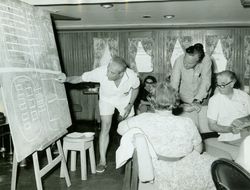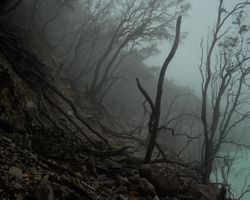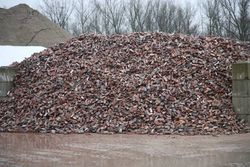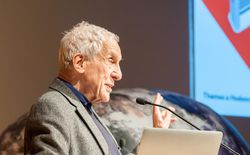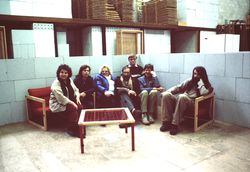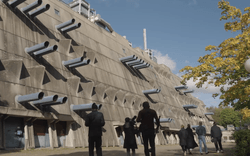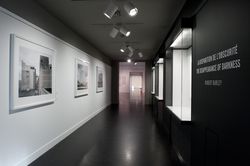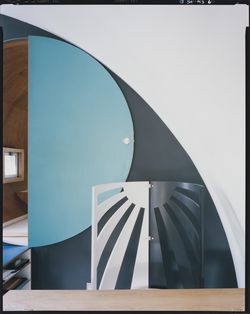En réaction à
En réaction à est une série de séminaires publics qui marqueront les dernières semaines de l’exposition L’architecte, autrement. Si l’exposition présente des modèles et approches alternatives qui ont remis en question les pratiques de design traditionnelles, ces séminaires offriront des points de vue de commissariat alternatifs sur l’exposition et sur la publication. Les(...)
Salles principales
10 mars 2016 au 1 avril 2016
En réaction à
Actions:
Description:
En réaction à est une série de séminaires publics qui marqueront les dernières semaines de l’exposition L’architecte, autrement. Si l’exposition présente des modèles et approches alternatives qui ont remis en question les pratiques de design traditionnelles, ces séminaires offriront des points de vue de commissariat alternatifs sur l’exposition et sur la publication. Les(...)
Salles principales
Lors de cette causerie, le photographe Bas Princen parlera de l’état d’avancement du projet 17 volcans, et évoquera les résonances existant entre les travaux de Franz Wilhelm Junghuhn, les œuvres de photographes néerlandais du début du XXe siècle (comme van Nieuwenhuis) à Java, ainsi que sa propre pratique. Si la découverte de nouveaux lieux semble impossible aujourd’hui,(...)
15 octobre 2016, 15h
Bas Princen : balades à dos de volcan
Actions:
Description:
Lors de cette causerie, le photographe Bas Princen parlera de l’état d’avancement du projet 17 volcans, et évoquera les résonances existant entre les travaux de Franz Wilhelm Junghuhn, les œuvres de photographes néerlandais du début du XXe siècle (comme van Nieuwenhuis) à Java, ainsi que sa propre pratique. Si la découverte de nouveaux lieux semble impossible aujourd’hui,(...)
archives
Niveau de description archivistique:
Collection
AP162
Résumé:
The Die gläserne Kette CCA Collection documents the chain of correspondence exchanged between German architects Hermann Finsterlin, Paul Goesch, Wenzel Hablik, Hans Hansen, Carl Krayl, Hans and Wassili Luckhardt, Hans Scharoun, and Bruno and Max Taut between 1919 and 1920 on the subject of utopian architecture and society. This CCA collection features original copies and reproductions of the correspondence, as well as a limited number of drawings by the members of the group.
1911-1977
Collection Die gläserne Kette
Actions:
AP162
Résumé:
The Die gläserne Kette CCA Collection documents the chain of correspondence exchanged between German architects Hermann Finsterlin, Paul Goesch, Wenzel Hablik, Hans Hansen, Carl Krayl, Hans and Wassili Luckhardt, Hans Scharoun, and Bruno and Max Taut between 1919 and 1920 on the subject of utopian architecture and society. This CCA collection features original copies and reproductions of the correspondence, as well as a limited number of drawings by the members of the group.
archives
Niveau de description archivistique:
Collection AP162
1911-1977
Michael Ghyoot et Maarten Gielen, membres du collectif Rotor, examinent les processus et les pratiques liés à la gestion matérielle des déchets dans Bruxelles et sa banlieue. La notion de déchet, construite à partir des visites rendues par centaines aux commerces, aux lieux de travail et aux centres de tri, a joué un rôle important dans cette recherche. En effet, l’étude(...)
Théâtre Paul-Desmarais
19 avril 2012 , 19h
L'enseignement de... Bruxelles : Rotor
Actions:
Description:
Michael Ghyoot et Maarten Gielen, membres du collectif Rotor, examinent les processus et les pratiques liés à la gestion matérielle des déchets dans Bruxelles et sa banlieue. La notion de déchet, construite à partir des visites rendues par centaines aux commerces, aux lieux de travail et aux centres de tri, a joué un rôle important dans cette recherche. En effet, l’étude(...)
Théâtre Paul-Desmarais
dessins, documents textuels, né numérique
AP181.S1.006
Description:
Original directory name: "05_Konsulenten". File contains records created and shared by COOP HIMMELB(L)AU and the various consultants on the project. These include PRO-Elektroplan GmbH, Bollinger+Grohmann, Dr. Pfeiler GmbH, Kersken + Kirchner GmbH., KBP Beratende Ingenieure GmbH, pbb planungsbüro balke, Ingenieurgemeinschaft BDP, a.g Licht, Realgruen Landschaftsarchitekten ,Lang + Burkhardt Verkehrsplanung und Städtebau, Emmer Pfenninger Partner AG, IB Rüdiger Schönenberg, Thomas A. Weisse + Partner. Bulk dates run from 2003-2006. Consultant expertise ranges from electricity, (electrical conveyor technology, Foerdertechnik) to structural physics (bauphysik), including open space planning (Freiflächenplanung), interior design (Inneneinrichtung), fire protection (Brandschutz), stage technology (Buehnentechnik), kitchen planning (Küchenplanung), facade engineering (Fassadentechnik), light design and planning (Lichtplaner), and solar panels for the roof. The records, largely plans, show the specific parts on which each of these consultants was working. The bulk of the records may be found under the “k_SSF_Ausführungsplanung/G_Pläne” directory which contains close to half of the records in this file. These are plans and views of the different areas and components of the BMW Welt building. These often include a CAD and a PDF version, some of which are annotated digitally or by hand prior to being digitized. CAD files include 2D drawings or 3D models, wireframes, screen captures, renderings, and plotter files. Records also include project management files, lists of the components of each room, engineering and analyses reports, many of which were digitized. Related to electrical and building engineering, there are a few databases in "c_PRO_Elektro_Foerdertechnik" and "b_KBP_Haustechnik". These contain information on the rooms and their technical requirements, such as equipment for plumbing, heat and ventilation, refrigeration systems, building automation, etc. Some database reports are also part of the records. Various sub-directories are named “quelldaten” (source data), which are typically zipped archives and often contain duplicate files. Duplicates were kept due to possible dependencies. Finally, the more than 7,000 plotter files across most directories suggest that printing physical copies of digital drawings for consultation was common practice. Early files (1997-2000) are AutoCAD Compiled Shape/Font File, AutoCAD Font Mapping Table, TrueType Font, and AutoCAD Colour-Dependant Plot Style Table. CAD files may depend on these to display drawings accurately. Most common file formats: Hewlett Packard Vector Graphic Plotter File, AutoCAD Drawing, Acrobat PDF 1.3 - Portable Document Format, Acrobat PDF 1.4 - Portable Document Format, ZIP Format
1996-2008
Consultants files for construction planning phase, BMW Welt, Munich
Actions:
AP181.S1.006
Description:
Original directory name: "05_Konsulenten". File contains records created and shared by COOP HIMMELB(L)AU and the various consultants on the project. These include PRO-Elektroplan GmbH, Bollinger+Grohmann, Dr. Pfeiler GmbH, Kersken + Kirchner GmbH., KBP Beratende Ingenieure GmbH, pbb planungsbüro balke, Ingenieurgemeinschaft BDP, a.g Licht, Realgruen Landschaftsarchitekten ,Lang + Burkhardt Verkehrsplanung und Städtebau, Emmer Pfenninger Partner AG, IB Rüdiger Schönenberg, Thomas A. Weisse + Partner. Bulk dates run from 2003-2006. Consultant expertise ranges from electricity, (electrical conveyor technology, Foerdertechnik) to structural physics (bauphysik), including open space planning (Freiflächenplanung), interior design (Inneneinrichtung), fire protection (Brandschutz), stage technology (Buehnentechnik), kitchen planning (Küchenplanung), facade engineering (Fassadentechnik), light design and planning (Lichtplaner), and solar panels for the roof. The records, largely plans, show the specific parts on which each of these consultants was working. The bulk of the records may be found under the “k_SSF_Ausführungsplanung/G_Pläne” directory which contains close to half of the records in this file. These are plans and views of the different areas and components of the BMW Welt building. These often include a CAD and a PDF version, some of which are annotated digitally or by hand prior to being digitized. CAD files include 2D drawings or 3D models, wireframes, screen captures, renderings, and plotter files. Records also include project management files, lists of the components of each room, engineering and analyses reports, many of which were digitized. Related to electrical and building engineering, there are a few databases in "c_PRO_Elektro_Foerdertechnik" and "b_KBP_Haustechnik". These contain information on the rooms and their technical requirements, such as equipment for plumbing, heat and ventilation, refrigeration systems, building automation, etc. Some database reports are also part of the records. Various sub-directories are named “quelldaten” (source data), which are typically zipped archives and often contain duplicate files. Duplicates were kept due to possible dependencies. Finally, the more than 7,000 plotter files across most directories suggest that printing physical copies of digital drawings for consultation was common practice. Early files (1997-2000) are AutoCAD Compiled Shape/Font File, AutoCAD Font Mapping Table, TrueType Font, and AutoCAD Colour-Dependant Plot Style Table. CAD files may depend on these to display drawings accurately. Most common file formats: Hewlett Packard Vector Graphic Plotter File, AutoCAD Drawing, Acrobat PDF 1.3 - Portable Document Format, Acrobat PDF 1.4 - Portable Document Format, ZIP Format
dessins, documents textuels, né numérique
1996-2008
Dans cette conversation, Kenneth Frampton discute les approches de l’histoire de l’architecture aujourd’hui, avec Esra Akcan (Cornell University) et Mark Jarzombek (Massachusetts Institute of Technology). Que signifie l’écriture d’une histoire globale de l’architecture au regard de l’urgence des enjeux contemporains? Au cours d’une discussion modérée par Kim Förster,(...)
6 avril 2017
Une conversation avec Kenneth Frampton : Peut-il y avoir une histoire globale de l’architecture aujourd’hui?
Actions:
Description:
Dans cette conversation, Kenneth Frampton discute les approches de l’histoire de l’architecture aujourd’hui, avec Esra Akcan (Cornell University) et Mark Jarzombek (Massachusetts Institute of Technology). Que signifie l’écriture d’une histoire globale de l’architecture au regard de l’urgence des enjeux contemporains? Au cours d’une discussion modérée par Kim Förster,(...)
Après une intense période de travail au milieu des années 1970 consacrée au initiatives d’habitation lancées au Portugal après la révolution, Álvaro Siza participe dans les années 1980 à deux des plus importants programmes de renouveau urbain en Europe : l’Exposition internationale d’architecture (IBA) de Berlin et le Stadsvernieuwing als Kulturel Aktiviteit (le renouveau(...)
26 novembre 2015
L’archéologie de l’ordinaire d’Álvaro Siza
Actions:
Description:
Après une intense période de travail au milieu des années 1970 consacrée au initiatives d’habitation lancées au Portugal après la révolution, Álvaro Siza participe dans les années 1980 à deux des plus importants programmes de renouveau urbain en Europe : l’Exposition internationale d’architecture (IBA) de Berlin et le Stadsvernieuwing als Kulturel Aktiviteit (le renouveau(...)
articles
Architecturer un changement
Forces de friction
9 décembre 2024
Architecturer un changement
Federica Zambeletti en conversation avec Arno Brandlhuber et Olaf Grawert
Actions:
Forces de friction
L’exposition Robert Burley : La disparition de l’obscurité présente une série de photographies de l’artiste canadien Robert Burley documentant la disparition des industries de produits photographiques traditionnels en réponse à l’impact des nouvelles technologies. Depuis 2005, la mutation de la technologie photographique, qui est passée de l’analogique au numérique, (...)
Vitrines
11 septembre 2009 au 15 novembre 2009
Robert Burley : La disparition de l'obscurité
Actions:
Description:
L’exposition Robert Burley : La disparition de l’obscurité présente une série de photographies de l’artiste canadien Robert Burley documentant la disparition des industries de produits photographiques traditionnels en réponse à l’impact des nouvelles technologies. Depuis 2005, la mutation de la technologie photographique, qui est passée de l’analogique au numérique, (...)
Vitrines
Figure ayant profondément marqué l’architecture d’après-guerre au Japon, Kazuo Shinohara s’est surtout fait connaître pour ses maisons individuelles. Or il reste peu étudié de nos jours, particulièrement à l’extérieur du Japon. Il a joint certaines formes traditionnelles et l’exploration de principes modernistes au moment des technologies de pointe et de l’information(...)
21 septembre 2017, 18h30
David B. Stewart, quel sens avait l’histoire pour Kazuo Shinohara?
Actions:
Description:
Figure ayant profondément marqué l’architecture d’après-guerre au Japon, Kazuo Shinohara s’est surtout fait connaître pour ses maisons individuelles. Or il reste peu étudié de nos jours, particulièrement à l’extérieur du Japon. Il a joint certaines formes traditionnelles et l’exploration de principes modernistes au moment des technologies de pointe et de l’information(...)
